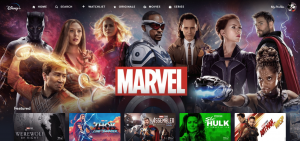
by Sienna Nicholson
Since 2008, the beloved comics of Marvel have taken over the big screen. The Marvel Cinematic Universe (or MCU) has shaped a strong fanbase of millions and continues to gain more as it transitions through each new phase. Avengers: Endgame was said to be the biggest triumph ever created. So what comes into question is, what will Marvel do next?
With the gradual start of Phase 4, several different opinions on Marvel’s projects have been expressed by adoring fans. The official critiques of professionals and amateurs on Twitter can be found with ease, each with its own captivating arguments. While there isn’t enough time to dive into each project that Marvel has created since the start of 2020, here’s my personal opinion on what’s the absolute best and worst projects of Phase 4.
Moon Knight – “Best of the Best”
At the top of the list is one of the most recent Phase 4 productions, Moon Knight. A six-episode TV show that was released on Disney+ in March of 2022 and finished in May of 2022.
Initially, Moon Knight seemed to be a very ambitious choice for a show because it didn’t catch the attention of most MCU fans. Moon Knight is a much lesser-known hero compared to the beloved Captain America or Iron Man. Many fans figured they would skip this show.
On the contrary, this show is definitely worth the watch.
Introducing Moon Knight to the MCU is one of, if not the best decision Marvel has ever made. This show is scripted beautifully by maintaining an excellent pace with an incredibly captivating plotline that keeps readers intrigued and on their toes.
If for some odd reason the action-filled plot doesn’t draw you in, the importance of the story told by the main character, Moon Knight/Marc Spector/Steven Grant, most definitely should. Both in the comics and the show, Moon Knight suffers from Dissociative Identity Disorder (DID), a mental disorder that is a response to childhood trauma.
While you may have heard of DID through projects such as Split, these works are infamous for their horrific demonization of the community. No accurate and delicate media has ever been created to represent this very real group of people. That is until Moon Knight.
Having a Marvel show display someone suffering from DID in a realistic, gentle, and positive lighting is a huge deal for the community. Several members with DID have complimented the show on being so caring in their representation.
Throughout the story, the dynamic between Marc and Steven is developed. The two struggle to navigate sharing one body. However, by revealing the trauma they’ve endured, they come to work together as Moon Knight to save the day.
Both Marc and Steven are well-rounded developed characters that go through evenly paced growth as the plot progresses through the episodes. The cast is full of complex three-dimensional characters. The villain of the story, Arthur Harrow, is the most obvious in this case. Arthur is written as a morally gray character whose pure goal is fulfilling Ammit’s will of clearing the world of “evil” and will go to any lengths to do it. Throughout the show Harrow slowly shows his true colors, gradually giving the audience reasons to dislike him until they eventually cheer for his defeat.
If there were to be any complaints about Moon Knight, it’d simply be that there should be more of it. Given a limit of six episodes to tell its entire story, the finale was oddly not utilized to its fullest potential. This left many unanswered questions, as well as a couple of important conversations left unsaid between vital characters such as Marc, Steven, and their shared love interest, Layla.
However, fans have high hopes for the possibility of a season 2 which will answer all as we get to see the wonderful Moon Knight system once again.
Doctor Strange: Multiverse of Madness – “Worst of the Worst”
Now, unfortunately, when there’s a best, there must be a worst.
While viewing the highly anticipated film Doctor Strange: Multiverse of Madness (released May 6th, 2022), the audience took away one idea: the cinematography was beautiful. With renowned horror director Sam Raimi directing the film, several gorgeous moments of fear and tension were displayed in this film.
Sadly, that’s the only compliment this movie has been rewarded.
The overall plot and character development of this film leave audiences unsatisfied. Despite being called the Multiverse of Madness, the multiverse was hardly utilized in this movie. Only two universes were explored in the film and one of them only consisted of a setting. The other universe is used solely for cameo after cameo to rally excitement for a total of fifteen minutes before they’re all killed off. Throughout the film, plenty of time is wasted on useless dialogue that doesn’t add to the plot in any way, shape, or form. Conversation and one-liners alike fall flat and there’s a handful of moments where characters feel stiff, making it impossible to emotionally connect with them.
Strange himself has a very weak and predictable arc of realizing sometimes you shouldn’t sacrifice for the greater good. His love interest, Christine, who hadn’t been addressed since the original Doctor Strange film, is suddenly brought back solely to get rid of her as quickly as possible so Strange’s new love interest, Clea, could be introduced.
Along with Strange is a cast of flat and motivationally ruined characters including Wanda. WandaVision, the first Marvel TV show of Phase 4, did a beautiful job expressing the process of grieving the loss of a loved one. It specifically dives deeper into how losing Vision affected Wanda and describes her unhealthy way of coping.
At the end of the show, Wanda reaches the final stage of grief: acceptance. A tear-jerker of a scene where she bids goodbye to both her husband and children leaves her longing, not vengeful.
That is until she arrives in Multiverse of Madness, where Wanda is suddenly hellbent on finding her children. The movie’s lame reasoning for this is that the spellbook she’s using has led her mind down a dark path, rather than giving any realistic character motivation outside of “she misses her kids.”
Despite her determination to reunite her family, her husband, Vision, is only mentioned a singular time as if Wanda seems to have moved on from him entirely.
With Wanda as our confusing antagonist, we’re given our McGuffin through America Chavez, who is a walking plot device used solely to move characters from universe to universe.
America isn’t given any time to truly grow as a character, or given any persona at all. Her arc is predictable and cliche. The idea of ‘if I believe in myself I can use my powers’ is the boring and unintelligent development that everyone saw coming. Outside of this, there’s no interest in her. She isn’t funny, she hardly talks, she is troublesome, and she is overall incredibly difficult to become attached to.
With such weak, ruined characters and an uninteresting plotline, Doctor Strange: Multiverse of Madness has landed itself at the bottom of the barrel for Phase 4.
As of now, the ratings are solidified, but there are plenty of Phase 4 productions to come. Maybe something will replace Multiverse of Madness as the worst project or perhaps an incredibly compelling story will surpass Moon Knight as number one. Either way, there’s definitely plenty more to come out of Marvel, and fans across the globe can’t wait.











